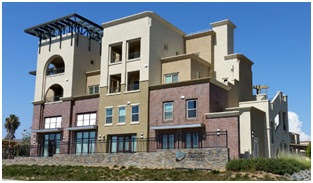As one of San Diego’s County’s fastest growing cities, San Marcos housing is on an upswing. The City is working to ensure that inventory includes options for all income levels.
It’s more than a notion. It’s a state mandate. San Marcos—like all California cities—is legally required to plan for housing needs across the socioeconomic spectrum. To do that, citieswork with developers who offer ‘affordable housing,’ which are typically apartments rented at discounted rates to people with lower or moderate incomes.
At face value, affordable housing might just seem like a box that must be checked. But San Marcos has found ways to leverage the affordable housing mandate into a catalyst for smart growth.
“Our approach is to make this legally-mandated program work for our growth strategy, not against it,” said San Marcos Communications Manager Robin Rockey.
For example, the Promenade at Creekside and Eastgate mixed-use affordable housing developments recently added 147 new apartments restricted for families of extremely low, very low and low income. By approving and funding these, the City was following the law—but it was also strategically using them to bring some much-needed improvements tothe community.
Both sit on the east end of the San Marcos Creek District, an area that lacked basic infrastructure. That infrastructure came in the form of new streets, drainage and lighting when the developments were built. The costs were covered by a complex layering of federal, state and city (the Successor Housing Agency) funding from the public sector, matched with private sector loans. Typically, an arrangement like that would take years to orchestrate—making this a big benefit to the City.
“We’re now launching our City’s biggest capital improvement project in that area, and we have a running head start thanks to these affordable housing developments,” Rockey explained.
Another case in point, in 2008, the City authorized funding for the Autumn Terrace mixed-use affordable housing development. The development added 100 new apartmentsrestricted as affordable housing, along with a new city street, which has resulted in faster emergency response times in the area.
“Police, ambulances and fire crews now have a cut through along Tiger Way, which allows them to get to residents faster—and that exists thanks to the affordable housing development that was built there,” Rockey said.
Of San Marcos’ approximately 30,400 homes—about 3,200 or 10 percent—of that inventory is dedicated to affordable housing. The City regularly updates its Housing Element of the General Plan, as mandated by law.
That state-approved housing plan also helps San Marcos qualify for state and federal grants. That grant money helped the City fund some major community assets, including Richmar Park.
Affordable housing also gives working families a safe, reliable place tolive.
“I think many people don’t realize that the residents who qualify for affordable housing are often professionals who work in our community,” Rockey said.
For example, San Marcos’ median income for a family of four is $86,300—which could qualify for affordable housing at the moderate-income level. Most families qualify at a lower level, closer to $64,2000.
“That range of salary covers many local professions, such as medical technician or entry-level teacher,” Rockey pointed out. “This is especially true for families who rely on only one income. We want to ensure that all San Marcos residents have access to quality housing options.”
To learn more about affordable housing opportunities, please contact Harry Williams, Housing Programs Manager or visit the Housing Programs page of our website.


















